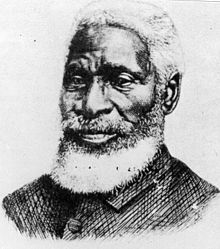The Life of Josiah Henson, Formerly a Slave, Now an Inhabitant of Canada, as Narrated by Himself

Josiah Henson
|
|
| Author | Josiah Henson |
|---|---|
| Country | United States |
| Language | English |
| Subject | Slavery in the U.S. |
| Genre | Autobiography |
| Published | 1849 Arthur D. Phelps, Boston |
| Followed by | Truth Stranger Than Fiction. Father Henson's Story of His Own Life |
The Life of Josiah Henson, Formerly a Slave, Now an Inhabitant of Canada, as Narrated by Himself is a slave narrative written by Josiah Henson, who would later become famous for being the basis of the character of Uncle Tom from Harriet Beecher Stowe's Uncle Tom's Cabin.The Life of Josiah Henson, published in 1849, is Henson's first work but was dictated to Samuel A. Eliot, who was a former Boston Mayor known for his anti-slavery views. Although Henson was an accomplished orator, he had not yet learned to read and write. The narrative provides a detailed description of his life as a slave in the south.
Henson’s autobiography was published in Boston in early 1849 by Arthur D. Phelps. Over the next three years, it sold 6,000 copies. It was reprinted after, with different pagination by the Observer Press of Dresden Ontario, for Uncle Tom’s Cabin and Museum in Dresden. When it was later known that Henson's narrative was the model for Uncle Tom’s Cabin, his sale increased to a total of 100,000 sales. In 1851 it appeared in London and Edinburg as The Life of Josiah Henson, formerly a Slave: As Narrated by Himself. It has now been reproduced by various publishing companies including Applewood Biks (ISBN ) and Dover Publications (ISBN ).
After the publication was released in 1849 it received little public attention until Harriet Beecher Stowe’s novel, Uncle Tom’s Cabin, was published in 1852. Soon after it became widely believed, and Stowe confirmed the connection, that Hensen's book and life experience was a major source of her work.
This slave narrative, begins with an ‘Advertisement.’ In the case of this book, the use of the word Advertisement is not to introduce a paid announcement to publicize a type of good or enterprise. Instead, its function is that of a notice to the readers to the fact that the work is the authentic work of Josiah Henson. The advertisement discusses the fact that the memoir was written from a dictation given by Josiah Henson, and so, the substance of the work is his own while “little more than the structure of the sentences belongs to another.” Through the paragraph long passage, to further authenticate the work, it expressly says that the work is “not fiction, but fact.” (Henson, 1)
...
Wikipedia
